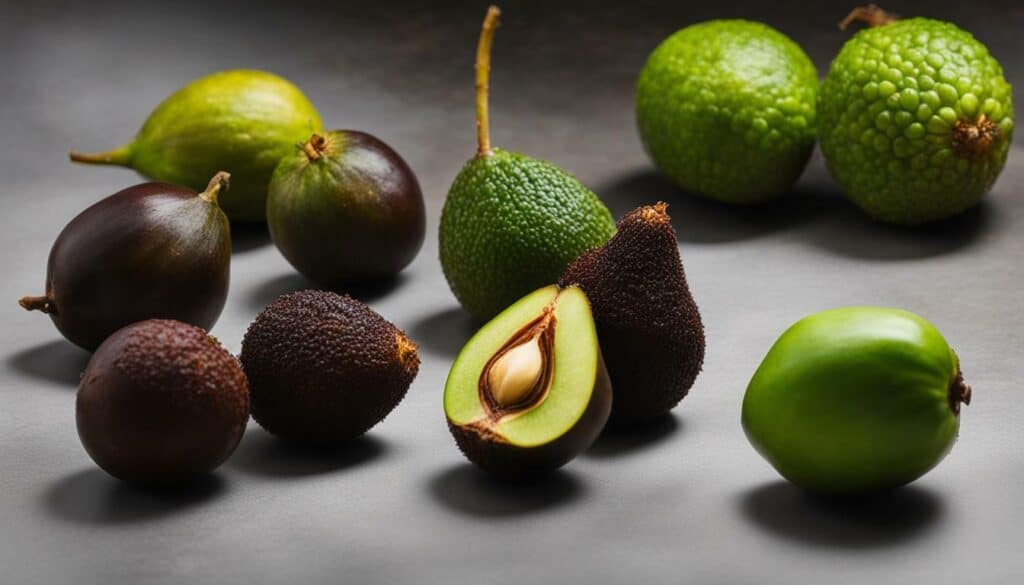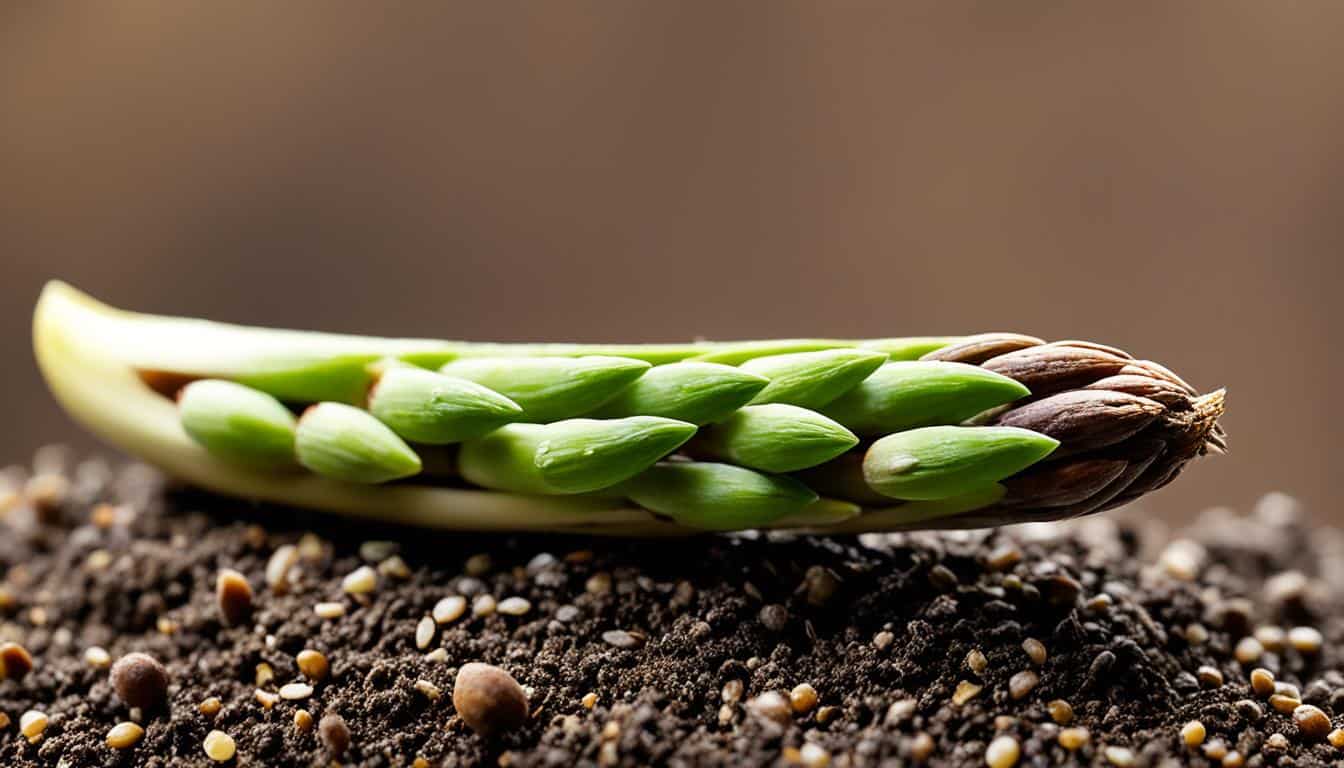Welcome to the world of Asam Jawa, also known as tamarind! In this article, we will dive into the tangy delights of this tropical fruit and discover how it adds a zestful punch to your cooking.
Asam Jawa, or tamarind, is a popular ingredient in Southeast Asian cuisines, known for its distinct tangy flavor. Whether it’s used in savory stir-fries, refreshing beverages, or as a tangy twist in desserts, tamarind adds a unique and delightful taste to dishes.
Key Takeaways:
- Tamarind, also known as Asam Jawa, is a tangy fruit used in Southeast Asian cuisines.
- It has a strong and sour flavor that adds depth to various dishes.
- Tamarind can be used in different forms, including unripe green fruit, ripe brown fruit, tamarind paste, and powder.
- This tropical fruit is rich in nutrients like vitamins (C, A, B1, B2), minerals (potassium, calcium, iron), and dietary fiber.
- Tamarind has antioxidant and anti-inflammatory properties and may benefit digestive health, heart health, blood sugar regulation, weight management, and immune system support.
The Versatility of Tamarind: From Green Fruit to Tamarind Paste
Tamarind comes in various forms, each with its own distinct taste and culinary applications. From the unripe green fruit to the commonly used tamarind paste, let’s discover the versatility of this tangy ingredient.
When tamarind is young and unripe, it is vibrant green in color and has a sour taste. It is often used in Southeast Asian cuisines for its tangy flavor that adds a refreshing twist to dishes. The unripe tamarind fruit can be used in salads, stir-fries, and even infused into drinks for a zesty kick.
As the tamarind fruit ripens, it turns brown and develops a sweeter and more complex taste. The brown tamarind fruit is commonly used to make tamarind paste, which is a concentrated form of tamarind pulp. Tamarind paste is widely used in various dishes, such as curries, chutneys, and marinades, to add a rich, tangy flavor.

Tamarind paste is a staple in many Southeast Asian kitchens and is a convenient way to enjoy the unique flavor of tamarind. It can be easily dissolved in water to make tamarind juice, or simply added to dishes to enhance their taste. Tamarind powder is another form of tamarind that is commonly used as a flavoring agent in snacks, candies, and sauces.
With its diverse range of applications, tamarind is truly a versatile ingredient that can add depth and tanginess to both savory and sweet dishes. Whether you’re looking to add a tangy twist to a traditional curry or explore the unique flavors of Southeast Asian cuisine, tamarind is a fruit that will surely delight your taste buds.
Discovering the Nutritional Powerhouse of Asam Jawa
Asam Jawa, or tamarind, is not only a flavorful ingredient but also a nutritional powerhouse packed with essential vitamins, minerals, and dietary fiber. Let’s explore the numerous health benefits this tangy fruit has to offer.
Tamarind is rich in vitamins, including vitamin C, which strengthens the immune system and promotes collagen production, leading to healthy skin and tissues. It also contains vitamins A, B1, and B2, which support overall health and well-being.
In addition to vitamins, tamarind is a great source of minerals such as potassium, calcium, and iron. Potassium helps regulate blood pressure and maintain a healthy heart, while calcium supports strong bones and teeth. Iron is essential for the production of red blood cells, ensuring proper oxygen transportation throughout the body.

Dietary fiber is another important component of tamarind. It aids in digestion, preventing constipation and promoting overall gut health. Fiber also helps control blood sugar levels and can contribute to weight management by promoting a feeling of fullness.
Furthermore, tamarind is known for its antioxidant and anti-inflammatory properties, which can help reduce cellular damage and inflammation within the body. These properties make it potentially beneficial for digestive health, heart health, blood sugar regulation, weight management, and immune system support.
However, it is important to consume tamarind in moderation. Excessive consumption may lead to dental problems, digestive disorders, and fluctuations in blood sugar levels. If you have any health concerns, it is always advisable to consult a healthcare professional.
Summary:
- Asam Jawa, or tamarind, is a flavorful ingredient with numerous health benefits.
- Tamarind is rich in essential vitamins (C, A, B1, B2) and minerals (potassium, calcium, iron).
- It is a great source of dietary fiber, aiding in digestion and weight management.
- Tamarind’s antioxidant and anti-inflammatory properties contribute to overall health and well-being.
- Consume tamarind in moderation and consult a healthcare professional if you have any health concerns.
| Vitamins | Minerals | Dietary Fiber | Health Benefits |
|---|---|---|---|
| Vitamin C | Potassium | Promotes digestion | Strengthens the immune system |
| Vitamin A | Calcium | Prevents constipation | Supports healthy skin and tissues |
| Vitamin B1 | Iron | Controls blood sugar levels | Regulates blood pressure |
| Vitamin B2 | Promotes weight management | Reduces cellular damage and inflammation |
Tamarind in Traditional Medicine: Healing and Protective Properties
For centuries, tamarind has been revered in traditional medicine for its healing and protective properties. Let’s uncover its potential benefits for weight loss, as well as its historical use in traditional medicinal practices.
Tamarind is known for its ability to support weight loss due to its high fiber content. The soluble fiber found in tamarind helps prevent overeating by promoting feelings of fullness and reducing appetite. Additionally, tamarind contains compounds that may help regulate fat metabolism and inhibit the production of enzymes involved in fat storage.
In traditional medicine, tamarind has been used for its hepatoprotective properties, which support liver health and detoxification. Studies have shown that tamarind may help protect the liver from damage caused by toxins and oxidative stress. Its natural antioxidants can help neutralize harmful free radicals and reduce inflammation in the liver.
“Tamarind has been used in Ayurvedic medicine for centuries to treat various ailments, including digestive disorders. Its natural laxative properties promote regular bowel movements and help relieve constipation. Tamarind also acts as a digestive stimulant, increasing the secretion of gastric juices and improving overall digestion.”
It’s worth noting that tamarind should be consumed in moderation, as excessive intake can lead to dental problems due to its acidity. Additionally, individuals with diabetes should monitor their blood sugar levels when consuming tamarind, as it may cause fluctuations. As always, it is best to consult a healthcare professional before incorporating tamarind or any new dietary supplement into your routine.
| Health Benefits of Tamarind | Traditional Uses |
|---|---|
| Supports weight loss | Used in Ayurvedic medicine for digestive disorders |
| Promotes liver health | Historically used for its hepatoprotective properties |
| Rich in antioxidants | Used in traditional medicine for its anti-inflammatory properties |
| Regulates blood sugar levels | Traditional remedy for diabetes management |
The Tangy Twist: Tamarind-Inspired Recipes to Try
Get ready to tantalize your taste buds with these delicious tamarind-inspired recipes! From tangy curries to refreshing beverages, we have a range of dishes that showcase the unique flavors of Asam Jawa.
Tamarind Glazed Chicken Wings
Kick off your culinary adventure with these lip-smacking Tamarind Glazed Chicken Wings. The tangy tamarind glaze perfectly balances the smoky flavors of the grilled chicken, creating a combination that is simply irresistible. With just a few simple ingredients, this recipe is a crowd-pleaser and a great addition to any barbecue or game night.
Tamarind-Mint Chutney
Looking for a refreshing accompaniment to your favorite Indian dishes? Look no further than this Tamarind-Mint Chutney. The tangy sweetness of tamarind is balanced by the fresh and vibrant flavors of mint, creating a versatile chutney that pairs well with samosas, kebabs, and other savory snacks. It’s quick and easy to make, and a small dollop of this chutney is sure to elevate your meals to the next level.
Tamarind Limeade
Cool down on a hot summer day with a glass of refreshing Tamarind Limeade. The tangy and citrusy flavors of tamarind and lime come together in this thirst-quenching beverage. Simply mix tamarind paste with lime juice, sugar, and sparkling water, and garnish with fresh mint leaves for an extra burst of freshness. This drink is perfect for entertaining guests or simply enjoying some time in the sun.
| Recipe | Preparation Time | Serving Size |
|---|---|---|
| Tamarind Glazed Chicken Wings | 45 minutes | 4-6 servings |
| Tamarind-Mint Chutney | 10 minutes | Approximately 1 cup |
| Tamarind Limeade | 15 minutes | 2-4 servings |
“Tamarind adds a tantalizing tang to these dishes, elevating them to new heights of flavor.”
– Chef John, The Flavorful Kitchen
With these tamarind-inspired recipes, you can embark on a culinary journey that showcases the versatility and unique flavors of Asam Jawa. Whether you’re a fan of tangy glazes, vibrant chutneys, or refreshing beverages, tamarind is sure to add a delightful twist to your dishes. So, go ahead and get cooking – the tangy delights of Asam Jawa await!
Enjoying Tamarind Beverages: Jawa Asam Drinks and More
Quench your thirst and experience the delightful tanginess of tamarind with these refreshing Jawa Asam drinks and more. These beverages will awaken your taste buds and keep you cool on hot summer days. Tamarind-based drinks are known for their unique flavor profile and are enjoyed by people of all ages.
One popular Jawa Asam drink is the Tamarind Cooler. Made with tamarind pulp, sugar, and water, this refreshing beverage offers the perfect balance of sweet and tangy flavors. Simply blend the tamarind pulp with water, strain it to remove any seeds or fibers, and sweeten it to taste with sugar. Serve it over ice and garnish with a sprig of mint for an extra refreshing touch.
If you prefer a fizzy drink, try the Tamarind Soda. Mix tamarind paste with soda water and add a squeeze of lime for a zesty twist. This effervescent drink is perfect for those who crave a bit of carbonation and a burst of tamarind flavor.
For a unique and exotic drink, indulge in the Tamarind Margarita. This cocktail combines the tanginess of tamarind with the kick of tequila, creating a perfect blend of flavors. Mix tamarind paste, lime juice, agave syrup, and tequila in a shaker with ice. Shake well and strain into a glass with salt rimmed. Garnish with a slice of lime for a touch of freshness.

The versatility of tamarind extends beyond beverages. It can also be used to make delicious tamarind-infused sauces, marinades, and dressings. Its tangy and sour taste adds depth and complexity to dishes, making them truly unforgettable.
So, go ahead and explore the wonderful world of tamarind beverages. From classic Jawa Asam drinks to inventive cocktails, there is a tamarind-based drink to suit every taste. Enjoy the tangy twist and savor the refreshing flavors that tamarind brings to your glass.
| Drink | Ingredients |
|---|---|
| Tamarind Cooler | Tamarind pulp, sugar, water, mint |
| Tamarind Soda | Tamarind paste, soda water, lime |
| Tamarind Margarita | Tamarind paste, lime juice, agave syrup, tequila, salt |
Moderation is Key: Potential Side Effects of Excessive Tamarind Consumption
While tamarind offers numerous benefits, it’s important to exercise moderation in its consumption. Let’s explore the potential side effects of excessive tamarind intake and the importance of consulting a healthcare professional.
Tamarind, also known as Asam Jawa, is a tangy fruit that is packed with nutrients. However, consuming too much tamarind can have adverse effects on your health. One potential side effect of excessive tamarind consumption is dental problems. The high acidity levels in tamarind can erode tooth enamel, leading to tooth sensitivity and decay. To protect your dental health, it’s essential to moderate your tamarind intake and maintain good oral hygiene.
Another potential concern is digestive disorders. Tamarind is known for its fiber content, which can aid in digestion. However, consuming too much fiber can cause gastrointestinal issues such as bloating, gas, and diarrhea. It’s vital to listen to your body and adjust your tamarind intake accordingly to avoid any discomfort or digestive problems.
Moreover, tamarind can affect blood sugar levels, making it a concern for individuals with diabetes or those at risk of developing the condition. Tamarind contains natural sugars that can cause spikes and drops in blood sugar levels. If you have diabetes or are monitoring your blood sugar, it’s crucial to consult with a healthcare professional to determine the appropriate amount of tamarind to consume.
Remember, moderation is key when enjoying the tangy delights of tamarind. It’s always advisable to seek guidance from a healthcare professional who can assess your individual health needs and provide personalized recommendations. By incorporating tamarind into your diet in a balanced way, you can savor its unique flavor and reap its many nutritional benefits.

Tamarind is not only beloved in Southeast Asian cuisines but also finds its place in various dishes around the world. Let’s take a journey across cultures and discover the global appeal of this tangy ingredient.
In Southeast Asian cooking, tamarind is a staple ingredient, adding a sour and tangy taste to dishes like Pad Thai, Massaman Curry, and Asam Laksa. Its distinct flavor is also prominent in Indian cuisine, where it is used in popular dishes like Sambar, Puliogare, and Chutneys. Tamarind is a key component in Mexican cuisine as well, making appearances in dishes like Agua de Tamarindo, Pozole, and Salsa Verde. Middle Eastern cooking also incorporates tamarind, particularly in dishes like Tamarind Chicken and Tamarind Soup. The unique flavor profile of tamarind adds depth and complexity to these diverse culinary traditions.
Across these cultures and cuisines, tamarind is used in a variety of forms. It can be seen in fresh tamarind pods, tamarind pastes and concentrates, or even as a powder. Each form lends itself to different dishes and recipes, making tamarind a versatile ingredient in global kitchens.
| Tamarind Recipe Ideas | Cuisine |
|---|---|
| Pad Thai | Southeast Asian |
| Sambar | Indian |
| Agua de Tamarindo | Mexican |
| Tamarind Chicken | Middle Eastern |
As you explore the world of tamarind-inspired dishes, don’t be afraid to experiment with this tangy ingredient in your own cooking. Its unique flavor profile will add a delightful twist to your meals, whether you’re preparing a traditional Southeast Asian curry or a fusion dish that combines various cultural influences. Let your taste buds embark on a flavorful journey with tamarind as a companion.
“Tamarind is a versatile ingredient that brings a tangy twist to dishes across cultures and cuisines.”
Summing it Up
Tamarind, known as Asam Jawa, is a tangy fruit that is not only beloved in Southeast Asian cuisines but also finds its place in dishes around the world. It adds depth and complexity to traditional recipes while bringing a unique flavor profile to international dishes. Whether you’re indulging in a comforting bowl of Indian Sambar or sipping on a refreshing Mexican Agua de Tamarindo, tamarind is a key ingredient that elevates the taste experience. So, embrace the global appeal of tamarind and let its tangy delights take you on a culinary adventure.

As we conclude our exploration of Asam Jawa, we hope you are inspired to incorporate this tangy fruit into your culinary repertoire. Discover the endless possibilities and add a zestful punch to your cooking with the delightful world of tamarind.
Tamarind, also known as Asam Jawa, is a versatile ingredient that can elevate the flavors of various dishes. Whether you choose to use the unripe green fruit, ripe brown fruit, tamarind paste, or powder, you can enjoy the strong and sour flavor that tamarind brings to the table.
Not only does tamarind add a unique tanginess to your meals, but it also offers numerous health benefits. Packed with essential vitamins, minerals, and dietary fiber, tamarind can support your overall well-being. Its antioxidant and anti-inflammatory properties may contribute to digestive health, heart health, blood sugar regulation, weight management, and immune system support.
It’s important to remember that moderation is key when consuming tamarind. While it has many positive attributes, excessive consumption can lead to dental problems, digestive disorders, and fluctuations in blood sugar levels. If you have any health concerns, it is always best to consult a healthcare professional.
FAQ
Q: What is tamarind?
A: Tamarind, also known as Asam Jawa, is a tangy fruit widely used in Southeast Asian cuisines. It has a strong and sour flavor that adds depth to various dishes.
Q: How can tamarind be used?
A: Tamarind can be used in different forms, including unripe green fruit, ripe brown fruit, tamarind paste, and powder.
Q: What are the nutritional benefits of tamarind?
A: Tamarind is rich in nutrients like vitamins (C, A, B1, B2), minerals (potassium, calcium, iron), and dietary fiber. It also has antioxidant and anti-inflammatory properties and potential benefits for digestive health, heart health, blood sugar regulation, weight management, and immune system support.
Q: Are there any traditional medicinal uses of tamarind?
A: Tamarind is used in traditional medicine for its hepatoprotective and skin-healing properties. It is also believed to have benefits for weight loss.
Q: What are the potential side effects of excessive tamarind consumption?
A: Excessive consumption of tamarind can lead to dental problems, digestive disorders, and fluctuations in blood sugar levels. It is important to consume tamarind in moderation and consult a healthcare professional if you have any health concerns.
Are Torch Ginger Flowers Also Tangy in Taste Like Tamarind?
Tropical torch ginger flower exploration reveals that these vibrant blooms have no tanginess reminiscent of tamarind. Torch ginger flowers offer a unique taste profile with hints of floral sweetness and subtle spiciness, but are not tangy like tamarind. Their distinct flavor adds a delightful touch to culinary creations and exotic beverages.









Leave a Reply